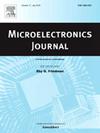Exploring the impact of sheet thickness scaling on Nanosheet FET gate electrostatics using k.p based simulations
IF 1.9
3区 工程技术
Q3 ENGINEERING, ELECTRICAL & ELECTRONIC
引用次数: 0
Abstract
This work explores the impact of sheet thickness scaling on gate electrostatics of NsFETs using k.p simulation. It is shown that thin channel NsFETs exhibit higher threshold voltage irrespective of the substrate orientation and channel material. However, the influence of geometrical confinement varies among different substrate orientations and channel materials due to variations in carrier quantization mass. It is also shown that thin channel NsFETs deliver higher inversion charges at equivalent gate over-drive voltages, thereby offering enhanced gate electrostatics. However, the advantage of gate electrostatics in thin channel NsFETs is limited by quantum capacitance. Optimizing the sub-band structure through strategic selection of substrate orientations and channel materials is essential to regulate quantum capacitance and to fully exploit the benefits of sheet thickness scaling in NsFETs.
求助全文
约1分钟内获得全文
求助全文
来源期刊

Microelectronics Journal
工程技术-工程:电子与电气
CiteScore
4.00
自引率
27.30%
发文量
222
审稿时长
43 days
期刊介绍:
Published since 1969, the Microelectronics Journal is an international forum for the dissemination of research and applications of microelectronic systems, circuits, and emerging technologies. Papers published in the Microelectronics Journal have undergone peer review to ensure originality, relevance, and timeliness. The journal thus provides a worldwide, regular, and comprehensive update on microelectronic circuits and systems.
The Microelectronics Journal invites papers describing significant research and applications in all of the areas listed below. Comprehensive review/survey papers covering recent developments will also be considered. The Microelectronics Journal covers circuits and systems. This topic includes but is not limited to: Analog, digital, mixed, and RF circuits and related design methodologies; Logic, architectural, and system level synthesis; Testing, design for testability, built-in self-test; Area, power, and thermal analysis and design; Mixed-domain simulation and design; Embedded systems; Non-von Neumann computing and related technologies and circuits; Design and test of high complexity systems integration; SoC, NoC, SIP, and NIP design and test; 3-D integration design and analysis; Emerging device technologies and circuits, such as FinFETs, SETs, spintronics, SFQ, MTJ, etc.
Application aspects such as signal and image processing including circuits for cryptography, sensors, and actuators including sensor networks, reliability and quality issues, and economic models are also welcome.
 求助内容:
求助内容: 应助结果提醒方式:
应助结果提醒方式:


